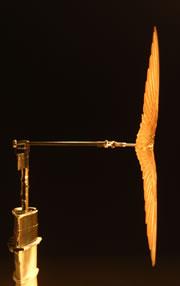 Contrary to previous studies, swifts generate lift most effectively by fully extending their wings.David Lentink
Contrary to previous studies, swifts generate lift most effectively by fully extending their wings.David LentinkThe average swift (Apus apus) travels 4.5 million kilometres in its lifetime — roughly the same as six round trips to the Moon. Now researchers have demonstrated how these adept aviators change the shape of their wings to improve performance, providing hints as to how aircraft engineers can improve their designs.
Common swifts spend nearly their entire lives in the air — eating, mating, and even sleeping 'on the wing'. It was this aerial lifestyle that drew the attention of David Lentink, a former aerospace engineer who is now working towards a doctoral degree in zoology at Wageningen University in the Netherlands.
Previous work looking at the flight of swifts has been based on theoretical models or experiments performed with imitation wings made of epoxy resin and metal. To improve on these surrogates, Lentink and his colleagues looked at 15 pairs of real swift wings, taken from dead birds from sanctuaries. They placed the wings in a wind tunnel and varied their orientation to measure the effect of wing shape and position on flight efficiency.
The results, reported this week in Nature1, show how swifts can adjust the shape of their wings to increase the efficiency of their glide or to make faster turns. Although some of these general principles of flight have been known for some time, Lentink's team were able to quantify the efficiencies; and at least one of their conclusions runs contrary to previous assumptions about the swift's flight.
The report is published just in time for the birds' annual return to the Netherlands after a winter spent in southern Africa — an event often celebrated as a sign of the start of summer. The cacophonous hoards arrived there just a few days ago.
Swoop and glide
The team found that extended wings provide the best slow glide, whereas those swept back away from the head function better at high speeds. Extremely fast turns require swept-back wings because extended wings would break under the extreme force. Swept-back wings also do not flutter, which protects against bone fractures under these conditions of high force.
Placing wings in the best formation for each activity means that the birds can fly 60% further in a single glide, and improve their turning efficiency by three times over how they would do with their wings poorly placed.
Lentink could also determine the glide speeds at which the birds would minimize energy expenditure — ideal for, say, taking a nap. That speed was eight to ten metres per second, the same speed at which the birds glide as they roost. "They have evolved an aerodynamic design for cheap flight," says Anders Hedenström, a theoretical ecologist at Lund University in Sweden and a co-author on the study.
Such information is useful — although perhaps not perfectly accurate. "The problem is a dead bird wing doesn't necessarily behave much like a live bird wing," says engineer Geoffrey Spedding of the University of Southern California in Los Angeles.
Hitching a lift
ADVERTISEMENT
But using a real wing is still much better than a model, says Spedding — and it sometimes throws up surprisingly different results. Previous studies using brass models had suggested that using swept-back wings helps swifts to boost lift by generating small vortices in the air-flow around the wings2. But Lentink's data contradict this theory; his results show that swifts generate lift more effectively by fully extending their wings.
This information could be used to improve the design of aircraft, Lentink says. Some planes, such as the F-14 Tomcat, already incorporate these principles by allowing the wings to sweep back when the plane is flying particularly fast.
Lentink says that these aircraft designs are crude compared with what the swifts can do, thanks to the engineering challenges involved. "The swifts are just better at it," he says, "The amount of feathers and muscle involved is challenging for us [to imitate]."
Engineers have a lot of things to consider, Spedding adds. For example, having flexible wings could require extremely heavy supports, cutting into any gains in fuel efficiency made by the wing shape. "Aeroengineers tend to look at you in horror when you suggest things like that," he says.
Visit our inawindtunnelshowse.html">newsblog to read and post comments about this story.
-
References
- Lentink D., et al. Nature, 446. 1082 - 1085 (2007). | Article |
- Videler J. J., Samhuis E.J. & Povel G.D.E. Science, 306. 1960 - 1962 (2004).
